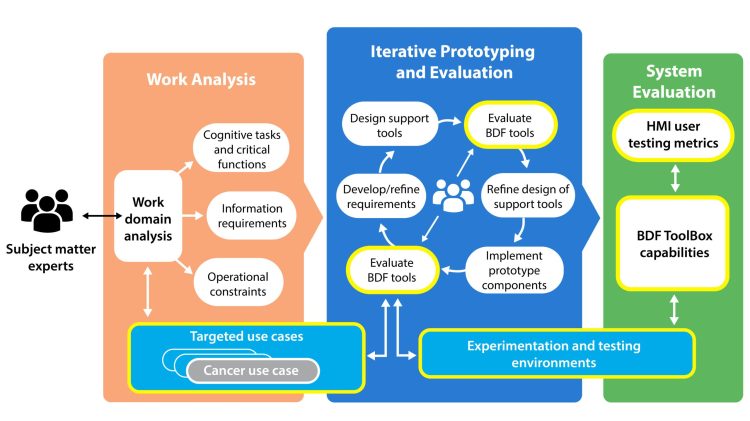ENHANCE
Improving biomedical data tools
through
user-centered, human-AI-focused design
Improving biomedical data tools through user-centered, human-AI-focused design
ENHANCE fosters user-centered development of ARPA‑H’s toolset

Unifying biomedical data to advance health outcomes
“We’re conducting user-centered testing to strengthen the BDF Toolbox, recruiting representative user types across multiple biomedical and technical literacy levels. Ultimately, the goal for ENHANCE is to make sure that the tools being created as part of the BDF program are actually the tools that need to be created and have all the necessary functionality for the user.”

Dr. Nicolette McGeorge
Senior Scientist and Principal Investigator on ENHANCE
Assessing human‑AI teaming tools
The first aspect of ENHANCE involves identifying the users and understanding their workflows and relevant sub use cases. Once the team members identify the users and their workflows, they can evaluate elements of the planned toolbox using principles of human factors engineering and cognitive systems engineering.
The team will be assessing the tools with principles of good usability practice with the goal of supporting an iterative design and refinement process so the toolbox elements can be improved early on. By evaluating the different complex elements, they aim to ensure positive outcomes for patients.
The BDF Toolbox will also incorporate AI into its framework, which means the ENHANCE team’s evaluation of the tool structure will also assess the effectiveness of human‑AI teaming elements. A key challenge when incorporating AI is understanding its limitations. Tools must be designed so that humans can recognize when AI has reached the bounds of its capabilities, just one facet of creating effective human-AI teams. ENHANCE will also support software verification and validation to ensure that the tools within the BDF Toolbox follow robust software engineering practices.

McGeorge is excited that ARPA‑H has valued a user-centered focus, and it’s why ENHANCE is such a value-add to the BDF Toolbox project. “We’re calling the project ENHANCE because it goes beyond the basic usability evaluation with enhanced approaches to iterative design and evaluation of tools at the intersection of humans and AI in complex environments,” she explains. It’s not just about having buttons in the right places, McGeorge cautions. “Users need clear, relevant information exactly when they need it, presented in a way that makes it easy to understand and helps them make decisions effectively. That context is critical,” McGeorge says.
Related Articles
NIH-National Cancer Institute (NCI): Advanced Research Projects Agency for Health (ARPA-H) Biomedical Data Fabric (BDF) Toolbox
NCI Cancer Research Data Commons (CRDC): Partners with ARPA-H on the Biomedical Data Fabric Toolbox Program
Contact us to learn more about our other capabilities in user interfaces and human-machine teaming, and health and medical tools.
This research was funded in part by the U.S. government. The views and conclusions contained in this document are those of the author(s) and should not be interpreted as representing the official policies, either expressed or implied, of the U.S. government.
